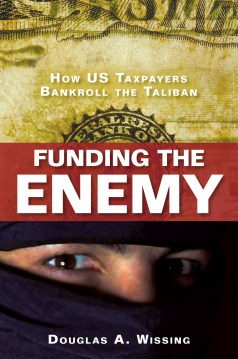 Marine General John Allen, the top U.S. commander in Afghanistan, was here in Washington two weeks ago saying the U.S. and the Afghan government are making progress in their decade-long battle with the Taliban. “We remain on track to ensure that Afghanistan will no longer be a safe haven for al-Qaida and will no longer be terrorized by the Taliban,” he said. “Our troops know the difference that they’re making every day, and the enemy feels that difference every day.”
Marine General John Allen, the top U.S. commander in Afghanistan, was here in Washington two weeks ago saying the U.S. and the Afghan government are making progress in their decade-long battle with the Taliban. “We remain on track to ensure that Afghanistan will no longer be a safe haven for al-Qaida and will no longer be terrorized by the Taliban,” he said. “Our troops know the difference that they’re making every day, and the enemy feels that difference every day.”
Now comes a decidedly contrary point of view. It’s from Douglas A. Wissing, author of the just-published Funding the Enemy: How U.S. Taxpayers Bankroll the Taliban. After spending time with U.S. troops in Afghanistan, he’s come to the conclusion that the U.S.-led effort there is flagging, if not already doomed. Battleland conducted this email chat with Wissing last week:
What share of the Taliban’s money do you estimate comes from illicit drugs? From the U.S. government?
I spent time in Afghanistan and in Washington trying to track that number down. One day at the U.S. embassy in Kabul, an American official serving in the Afghan Threat Finance Cell (ATFC) talked to me. The ATFC is comprised of about 30 specialists on loan from the Department of Drug Enforcement, the Department of Treasury, the Department of Justice, the Department of Defense’s CENTCOM, the CIA, and the FBI, who try to identify and disrupt sources Taliban funding. They are the experts.
The official told me that U.S. government officials estimated the insurgents’ annual budget to be in the hundreds of millions of dollars. “Is it $1 billion? $500 million? The total amount is a tail people are going to chase until the end of time,” he told me. “We know they are raising substantial amounts of money; they can finance their operations. If you take away the Gulf money, they can make it up. If you take away the narco money, they can make it up. It’s like punching Jello.”
The official confirmed the U.S. and civilian reports that the insurgents used extortion of U.S. development and logistics contracts for their funding. He cited logistics-convoy security shakedowns, construction-protection rackets, Taliban “taxes” on corrupt officials, payoffs from international NGOs and major Afghan businesses—such as cell phones, utilities, and banks—as well as skims from poorly overseen Afghan government projects of the National Solidarity Program.
Citing the flood of American development and logistics money pouring into Afghanistan, the official said, “The more money that comes in here, the more opportunities, and then there’s a lot more exploitation, more corruption. And there’s a lot more money coming in here.”
Why do you believe the Taliban is getting so much money from U.S. taxpayers? Is this just the way things work – or don’t – in a counter-insurgency?
The Taliban is getting so much money from U.S. taxpayers because there is a toxic, opportunistic system that developed in Afghanistan in the years after the U.S. invasion. The system connects distracted American careerists, private U.S. corporations, corrupt Afghan kleptocrats—and the Taliban. U.S. soldiers compare it to the Mafia: everyone’s in on the take. The soldiers tell me, “We are funding our own enemy.”
Because of the corrupt Afghan government leadership, this particular counterinsurgency is particularly rife with skims and scams of U.S. logistics and development contracts, which ultimately help finance the Taliban—what the military calls “threat funding.”
The U.S. military leaders have to know that counterinsurgency won’t work with a corrupt Afghan government. FM 3-24, the famous counterinsurgency manual authored by General David Petraeus that guides the U.S. military strategy in Afghanistan, states that partnering with a legitimate host government is an indispensable “north star” to a successful war. Instead, the U.S. is allied with an Afghan government that is largely ineffective and systemically corrupt.
Why did you write Funding the Enemy: How U.S. Taxpayers Bankroll the Taliban?
When I was embedded with U.S. troops in eastern Afghanistan, the soldiers started telling me that the U.S. government is wasting tens of billions of American taxpayer dollars on scandalously mismanaged aid and logistics contracts that end up financing the Taliban.
We’d be trundling through Taliban-controlled areas in armored vehicles, dodging ambushes and hitting IEDs, and the soldiers would be saying, “We’re funding both sides of this war.” It seemed preposterous at first. But as I dug into the story, officers, diplomats, and aid officials confirmed the rough outlines of the pernicious system. One sardonic US intelligence officer told me, “It’s the perfect war. Everyone is making money.”
I was trained as a historian, so wanted to understand the origins of this system. As a journalist, I wanted to see how the patterns played out on a day-to-day level. And I wanted Americans to know the reality of the war in Afghanistan.

Tyagan Miller
What background do you have to reach the conclusions you did? Why should we listen to you?
As an independent journalist who has contributed to outlets that include the New York Times, Los Angeles Times, Washington Post, Foreign Policy, BBC, and VOA News, I’ve devoted considerable amounts of time and resources to objectively research development and logistics funding in Afghanistan.
I have a fair amount of experience in Central Asia, including time in the Pashtun tribal regions pre-9/11 and long stints among the famous Khampa Buddhist warriors of eastern Tibet in the process of researching my book, Pioneer in Tibet: The Life and Perils of Dr. Albert Shelton. Through the Khampa tribesmen, I learned about warrior cultures—knowledge that stood me in good stead in Afghanistan, where I encountered the intersecting worlds of fundamentalist Islamic mujahideen and devout American Baptist soldiers.
I’ve read a mountain of documents, reports, and books on the war in Afghanistan, conducted hundreds of interviews with people on all stripes and persuasions, embarked on two embeds in the war-zones of eastern Afghanistan. I’ve been in combat zones and Kabul embassy offices; in a little white taxi winding through way through a bomb-blasted landscape to Bagram Air Field; slogged with U.S. patrols through the Taliban-held mountains in 50 pounds of body armor; billeted in front-line bases where the blare of big-screen TVs and the hiss of espresso machines is punctuated with the boom of incoming rockets and the stutter of Kalashnikovs; shared the poignant front-line ceremonies honoring fallen soldiers returning homeward.
I’m an honest broker; I’m not beholden to the system. Based on my research and analysis, I’ve determined that grotesquely mismanaged U.S. taxpayers’ money is making its way to the Taliban. We are fighting a war while funding our enemy—hence, the title of my book.
Tell us what you saw on the ground in Afghanistan.
I saw a dysfunctional, often uncoordinated development system that placed an emphasis on spending money fast, but had little interest in measuring the impacts of billions of U.S. taxpayers’ dollars on reducing the insurgency.
I saw that messages that sound so good from podiums in Washington have little correlation with the on-the-ground reality in Afghanistan.
I saw an ADD-afflicted U.S. military and civilian leadership embark on a merry-go-round of sequential, sometimes contradictory strategies that has eventually cost us the war.
I have seen courageous American soldiers get increasingly frustrated and cynical about the war. Last summer a Marine colonel in southern Afghanistan told me there was low morale among the troops. He said, “On an operational level, the soldiers are saying, ‘I’m going to go over there and try to not get my legs blown off. My nation will shut this bullshit down.’ That’s the feeling of my fellow soldiers.” The marine officer said, “The juice ain’t worth the squeeze.”
What do you think the U.S. should do now in Afghanistan?
We’re now spending $2 billion dollars a week in Afghanistan. We spent $120 billion there last year. It is not doing much good. Most of the $60 billion the U.S. has spent in Afghanistan on aid and development is wasted. After investing $30 billion on standing up the Afghan national security forces, their performance is still abysmal.
By most accounts, the insurgency is rapidly growing. Afghans don’t want us there. Increasing numbers of Americans want the U.S. forces to leave Afghanistan as soon as possible. Most of the soldiers I talk to want to get out.
I think the U.S. officials need to accelerate the withdrawal of the troops, and prepare to assist with the inevitable humanitarian crisis that is bound to overwhelm Afghanistan when we leave. We broke it. We need to help pick up the pieces.


